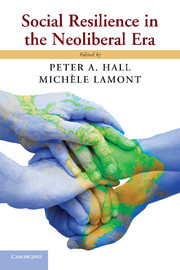Book contents
- Frontmatter
- Contents
- Contributors
- Foreword
- Prologue
- Acknowledgments
- Introduction
- Part I Neoliberalism
- Part II The Social Sources of Individual Resilience
- 4 Responses to Discrimination and Social Resilience Under Neoliberalism
- 5 Stigmatization, Neoliberalism, and Resilience
- 6 Security, Meaning, and the Home
- Part III Social Resilience on a Macro Scale
- PART IV Communities and Organizations as Sites for Social Resilience
- Index
- References
6 - Security, Meaning, and the Home
Conceptualizing Multiscalar Resilience in a Neoliberal Era
Published online by Cambridge University Press: 05 May 2013
- Frontmatter
- Contents
- Contributors
- Foreword
- Prologue
- Acknowledgments
- Introduction
- Part I Neoliberalism
- Part II The Social Sources of Individual Resilience
- 4 Responses to Discrimination and Social Resilience Under Neoliberalism
- 5 Stigmatization, Neoliberalism, and Resilience
- 6 Security, Meaning, and the Home
- Part III Social Resilience on a Macro Scale
- PART IV Communities and Organizations as Sites for Social Resilience
- Index
- References
Summary
Introduction
To say that one's home is a significant contributor to social resilience may seem self-evident. Indeed, housing is fundamental to so many areas of social life as to make its importance nearly tautological. Housing and home are a site for and constitutive of crucial social phenomena that include gender, family, child development, health, social relationships, wealth, identity, ethnicity, culture, aging, and many other indicators and determinants of resilience. Indeed, its embeddedness within so many spheres of social life makes its importance challenging to distinguish, leaving it to be taken for granted.
The housing sector has arguably been a critical sector for the unfolding of neoliberalism, although relatively few aspects of this relationship have been examined in the mainstream literature on neoliberalism. Notable neoliberal transformations in the housing sector include the selling off of nearly one-third of Council housing stock in the United Kingdom in the late 1980s and early 1990s under the Right to Buy policy (Ginsburg 2005; Mullins and Murie 2006), the effective elimination of new investments in public housing in Canada in the name of deficit reduction starting in 1993 (Wolfe 1998; Hulchanski 2004), and the stealthy retrenchment from its role as a public landlord by U.S Department of Housing and Urban Development in the United States in favor of a voucher-based system with delivery of housing units by the private rental sector (Schwartz 2010). These represent an important means by which neoliberal governments shrank the state in the 1980s and 1990s consistent with neoliberal doctrine. Although some of these changes could be viewed as part of a continuous evolution of liberal doctrine (especially the Right to Buy policy as a continuation of a historical thrust toward more home ownership), changes in public housing provision to market delivery mechanisms in many countries, including the United States and Germany, signal a neoliberal shift. Most importantly, the establishment and growth of large, publicly funded and publicly managed physical housing stocks and related programs in the early part of the twentieth century has been progressively reversed in the neoliberal era.
- Type
- Chapter
- Information
- Social Resilience in the Neoliberal Era , pp. 183 - 206Publisher: Cambridge University PressPrint publication year: 2013
References
- 8
- Cited by

